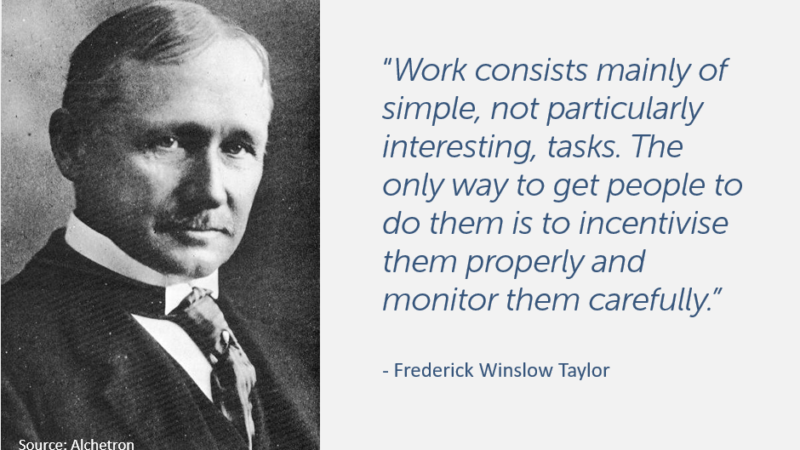- 13 March 2017
- Michael McGrath
Part 1/3 – Why most staff motivation strategies aren’t working

Improving staff motivation leads to a more productive workforce, and yet most business leaders are going about it the completely wrong way. In fact, most management structures and staff reward programs are having the opposite effect of demotivating staff!
Ask any Australian how they define success and chances are you’ll hear the same song to a different tune over and over. It’s not about money, although the absence of financial stress and ability to afford experiences that create rich memories can contribute to happiness.
Rather, you’ll most commonly hear that success is measured by happiness, health and thriving relationships. Intuitively we know that money is only a small part of the puzzle and certainly not the end game.
NAB research published in October 2016 revealed that “happiness ranks as the top measure of personal success in Australia, but that there is a disconnect between what Aussies value personally and what we think society values.”
“NAB’s whitepaper ‘Rethink Success’ reveals that Australians, from Generation Z through to Baby Boomers, rank success by:
- Happiness
- Good family relationships
- Feeling fit and healthy
- Being a ‘good person’
- Having a good marriage
- Having good mental health
- Being in control of my life
- These are all above buying a house (15), being rich (22) and being financially secure (8).
Over recent months, like many of you I have experienced a sense of growing unease as I see so much sadness in the world and try to make some kind of sense of it all. Turn on the evening news for half an hour or take a scroll through a social media feed and you can expect to be bombarded with misery, stemming from intolerance, hatred, and a lack of empathy for those different to ourselves.
It’s lead me to contemplate the way of life we’ve come to accept as normal in our relatively insulated bubble in Australia, and evaluate whether we’re really taking advantage of our incredible fortune by pursuing our Australian definition of success as well as empowering those around us to do the same.
Take a look at the average workplace and you’ll find a vast majority working hard to impress bosses / shareholders / board members by producing deliverables that don’t drive change, to achieve arbitrary goals and KPIs that they aren’t passionate about, pursuing status and money to buy things they don’t need to live the successful life we all purport to be aspiring to.
Are they happy, fulfilled and motivated? Unlikely.
In a country so full of opportunity compared to the rest of the world, most of us are chasing our tails pursuing society’s idea of success at the cost of living our own definition of a successful life – one that prioritises happiness and quality relationships.
Ironic, isn’t it.
How are businesses going about motivating staff now?
Though it seems obvious to state that a happy and motivated team will perform better, what is less obvious is how to provide a happy and motivating workplace, cost effectively and without compromising on productivity.
Businesses have typically approached the challenge with a ‘carrot and stick’ (rewards and punishment) methodology: incentivise desired behaviour with rewards, money and recognition, and minimise undesirable behaviour through annual performance reviews, management oversight and thorough supervision.
It makes sense.
But it’s entirely wrong.
In this three part series, we explore the latest research from Daniel Pink’s book ‘Drive’ on what truly motivates staff and detail steps you can take to propel your business forward to a new level of efficiency, collaboration and innovation.

So what is the most effective way to motivate staff without compromising on productivity?
I recently read the book ‘Drive’ by Daniel Pink investigating the surprising truth about human motivation. Making Business Insider’s ‘Top 10 books that every manager should read’ list, it provided some deeply resonating insights that should revolutionise the way we consider the leadership role within our businesses. (I strongly recommend you read it!)
Pink delineates thought-provoking research surmising that “when it comes to motivation, there’s a gap between what science knows and what business does.”
For employees required to use any level of creative thought in their role – as opposed to purely rote, algorithmic tasks – the traditional ‘carrot and stick’ form of incentivising staff is not only ineffective, but is actually demotivating!
That’s right, providing awards, incentives and rewards for your staff could be what’s holding your company back from reaching its potential!
The reason is that humans are most creative and productive when intrinsically motivated, that is, motivated from within. By offering performance incentives, the human mind shifts from seeing an interesting task as an opportunity for creativity and mastery, to a drudge that must be performed in order to reach a goal set by a manager.
Rewards turn play into work.
Rather than improved performance, ‘if-then’ rewards tend to result in:
- Reduced intrinsic motivation
- Diminished creativity and performance
- Increased cheating, shortcuts and unethical behaviour
- Addictive tendencies that over-ride quality work
- Short term thinking that cna sabotage a business’ long term interests
Briefly reflecting on your own career you can probably recall feeling somewhat patronised at the arbitrary nature of a manager’s feedback or a company award, particularly if it is not an authentic extension of a company culture that genuinely cares for staff wellbeing.
You can also probably easily imagine a scenario where a sales representative has a commission to sell a product. They will go to great lengths to convince anyone and everyone that the product meets their needs. Sales go up, commission is paid and management is happy reviewing the next quarterly report.
Fast-forward a year and you probably have a suite of low value or unimpressed clients who have heavily invested in a product they are quickly learning doesn’t really meet their needs. They now don’t trust your sales representative enough to buy from your business again. Staff motivation is low, attrition is high, sales go down and management are not happy. Rarely though, is this attributed to a flawed system of incentivising staff.
That’s not to say that remuneration, recognition and rewards are unimportant. They just need to be provided with authenticity and with a thorough understanding of how human motivation really works.
In the next post we explain Daniel Pink’s three key elements of human motivation along with his practical guide to how the elements of human motivation can be applied to your business.
References:

